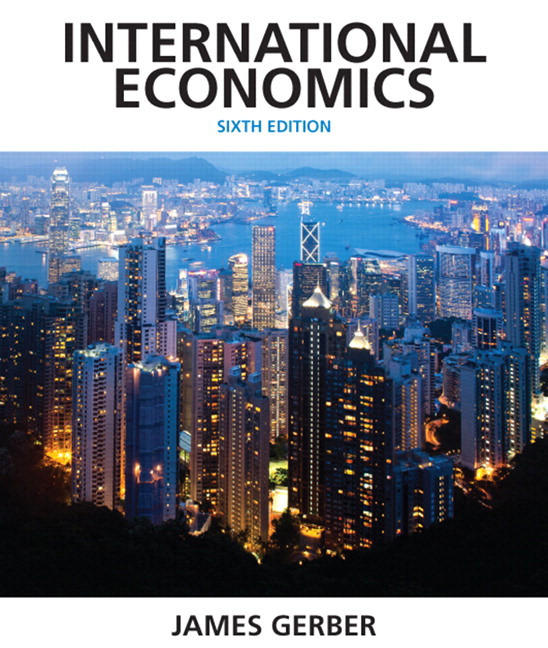Test Bank for International Economics, 6/E 6th Edition James Gerber
$35.00 Original price was: $35.00.$26.50Current price is: $26.50.
Test Bank for International Economics, 6/E 6th Edition James Gerber
Instant download Test Bank for International Economics, 6/E 6th Edition James Gerber pdf docx epub after payment.
International Economics, 6e (Gerber)
Chapter 1 The United States in a Global Economy
1.1 Introduction: International Economic Integration
1) There are no questions for this section.
Topic: Introduction: International Economic Integration
1.2 Elements of International Economic Integration
1) Countries such as the United States that have large populations tend to have
A) higher trade-to-GDP ratios.
B) lower trade-to-GDP ratios.
C) relatively greater capital outflows.
D) relatively smaller capital outflows.
E) None of the above.
Answer: B
Topic: Elements of International Economic Integration
2) The trade-to-GDP ratio for a nation that had $600 million in exports, $400 million in imports, and GDP of $2,000 million would be
A) 0.1.
B) 0.2.
C) 0.5.
D) -0.1.
Answer: C
Topic: Elements of International Economic Integration
3) The trade-to-GDP ratio is calculated by
A) exports divided by GDP.
B) imports divided by GDP.
C) exports plus imports divided by GDP.
D) exports minus imports divided by GDP.
E) exports divided by imports.
Answer: C
Topic: Elements of International Economic Integration
4) A relative measure of the importance of trade is
A) the dollar value of trade.
B) trade as a percentage of GDP.
C) the dollar value of trade adjusted for inflation.
D) trade as a percentage of investment.
E) None of the above.
Answer: B
Topic: Elements of International Economic Integration
5) An important factor that increased international capital flows in the latter part of the 1800s was
A) the creation of the International Monetary Fund.
B) the creation of numerous regional trade agreements.
C) the rapid rate of East Asian economic growth.
D) technological innovations.
E) the creation of the World Bank.
Answer: D
Topic: Elements of International Economic Integration
6) Labor mobility was
A) less in 1900 than in 2010.
B) unimportant to global integration until the 1960s.
C) greater in 1900 than in 2010.
D) never controversial.
E) a brand new feature of the global economy in the twenty-first century.
Answer: C
Topic: Elements of International Economic Integration
7) A major impact of the transatlantic telegraph was
A) a reduction in time required to complete a financial transaction between New York and London
B) an increase in labor flows across the Atlantic.
C) a decrease in trade barriers between the United States and Europe.
D) an increase in trade conflicts between the United States and Europe.
E) that nations abandoned the gold standard.
Answer: A
Topic: Elements of International Economic Integration
8) The trade-to-GDP ratio for the United States reached its lowest point of the last 100 years
A) around 1900.
B) around 1970.
C) around World War II.
D) around World War I.
E) around 2008.
Answer: C
Topic: Elements of International Economic Integration
9) Countries that have high rates of savings also have
A) high rates of investment.
B) low rates of investment.
C) stock market bubbles.
D) low rates of growth.
E) no international trade.
Answer: A
Topic: Elements of International Economic Integration
10) Since the end of World War II,
A) world trade has grown more slowly than world GDP in the same time period.
B) world trade has grown more slowly than during the years leading up to World War II.
C) the trade-to-GDP ratios of most countries have fallen.
D) trade is less important to most nations’ economies than in the early part of the twentieth century.
E) world trade has grown more rapidly than world output.
Answer: E
Topic: Elements of International Economic Integration
11) One of the reasons we know that international labor mobility has been higher at other times is because
A) the percent of our population that was foreign born was higher.
B) the percent of our population that was foreign born was lower.
C) wages were lower.
D) labor was important in agriculture.
E) the population was younger.
Answer: A
Topic: Elements of International Economic Integration
12) One important difference between the international economy of today and the economy of 100 years ago is
A) that labor is so much more mobile.
B) for the first time, technological innovations have reduced the barrier of distance.
C) for the first time, capital is mobile.
D) that price differences in different markets have narrowed.
E) the presence of international bodies such as the IMF and World Bank.
Answer: E
Topic: Elements of International Economic Integration
13) One of the distinguishing characteristics of capital mobility today is that
A) there are far more kinds of financial instruments than there were 100 years ago.
B) nations are no longer dependent on their own national savings for their investment funds.
C) the bulk of foreign capital flows are tied to labor flows.
D) foreign capital flows are better managed and rarely cause financial problems.
E) currency markets play a less significant role than they did in the past.
Answer: A
Topic: Elements of International Economic Integration
14) Which of the following is FALSE?
A) Capital flows today are larger mainly because economies are larger.
B) The last two decades are the first time in history that a nation has borrowed more than 10 percent of its GDP.
C) There are important qualitative differences between capital flows today and in the past.
D) In 1900 most international financial transactions involved buying and selling bonds.
E) Today most international financial transactions involve buying and selling assets denominated in foreign currencies.
Answer: B
Topic: Elements of International Economic Integration
15) Your text mentions several ways that international trade flows are qualitatively different than they were a century ago. Which of the following is NOT one of those ways?
A) Manufactured goods are more important than the were in the past.
B) Firms’ investment spending on capital goods is more important than in the past.
C) International trade in raw commodities and agricultural products is more important than it was in the past.
D) It is possible to trade some types of services in a way that was not possible in the past.
E) Multinational corporations play a bigger role in production than they did in the past.
Answer: C
Topic: Elements of International Economic Integration
16) Financial capital flows could include
A) real estate purchases.
B) construction of factories.
C) sales of a business.
D) the purchase of the physical assets and operations of a multinational corporation by another.
E) currency market transactions.
Answer: E
Topic: Elements of International Economic Integration
17) An example of a foreign direct investment (FDI) would include
A) a U.S. couple buying land for their dream retirement home in Costa Rica.
B) a U.S. mutual fund manager buying shares of stock in a Brazilian oil company.
C) a U.S. firm expanding its U.S. operations.
D) a Chinese consumer buying an imported Japanese car.
E) a wealthy Mexican buying U.S. Treasury bills.
Answer: A
Topic: Elements of International Economic Integration
18) All of the following are differences in capital flows today from the past, EXCEPT
A) the increasing variety of financial instruments.
B) the larger number of companies listed on world stock exchanges.
C) the need to protect from sudden changes in currency values.
D) the problem of volatility in financial capital flows.
E) the reduction in transaction costs for foreign investment.
Answer: D
Topic: Elements of International Economic Integration
19) Which of the following is TRUE?
A) Domestic policies are never barriers to trade.
B) Programs aimed at supporting domestic industries do not form trade barriers today.
C) Tariffs and quotas in industrial nations are significantly higher now than they were in 1950.
D) Tariffs and quotas are the primary trade barrier in industrialized countries.
E) Domestic policies intended to protect consumers or the environment may become trade barriers.
Answer: E
Topic: Elements of International Economic Integration
20) Economists
A) describe reducing tariffs and quotas as shallow integration.
B) describe reducing tariffs and quotas as deep integration.
C) believe that changing domestic policies affecting trade is a relatively simple process.
D) believe that the work of reducing trade barriers is done since most tariffs are low and most quotas eliminated.
E) believe the original motivation for nations forming domestic policies and regulations was to create trade barriers to foreign companies.
Answer: A
Topic: Elements of International Economic Integration
21) Deep integration
A) is easier to achieve than shallow integration.
B) is less controversial than shallow integration.
C) does not require changing domestic policies unrelated to tariffs and quotas.
D) requires cooperation with other national governments or international bodies.
E) can be implemented unilaterally.
Answer: D
Topic: Elements of International Economic Integration
22) Made in the USA or Made in China has less meaning for products that
A) are a commodity such as iron ore.
B) are an agricultural product such as wheat.
C) are a product that is technological and involves assembling many different types of sometimes sophisticated components.
D) are a product that is produced and consumed domestically.
E) were produced fifty years ago versus the types of products manufactured today.
Answer: C
Topic: Elements of International Economic Integration
23) Which of the following kinds of agreements between two or more countries would be an example of a shallow integration measure?
A) An agreement to accept another nation’s certification of architects
B) An agreement to unify customs forms in order to speed up cross-border traffic
C) An agreement to use the same environmental standards
D) An agreement to impose the same limits on cartels and monopolies
E) An agreement to limit subsidies offered to domestic businesses
Answer: B
Topic: Elements of International Economic Integration
24) Which of the following kinds of agreements between two or more countries would be an example of a deep integration measure?
A) An agreement to reduce tariffs and quotas
B) An agreement to unify customs forms in order to speed up cross-border traffic
C) An agreement to impose the same limits on cartels and monopolies
D) An agreement to reduce exports
E) An agreement to limit imports
Answer: C
Topic: Elements of International Economic Integration
25) While the world was fairly integrated at the turn of the last century, most trade was in agricultural and raw materials, whereas today manufactured consumer and producer goods play a much greater role in determining exports and imports.
Answer: TRUE
Topic: Elements of International Economic Integration
26) Capital and labor only very recently have been free to move across international borders.
Answer: FALSE
Topic: Elements of International Economic Integration
27) Capital flows between countries are smaller than in past decades in absolute terms.
Answer: FALSE
Topic: Elements of International Economic Integration
28) Open economies grow slower than closed ones.
Answer: FALSE
Topic: Elements of International Economic Integration
29) Daily foreign exchange transactions have grow from about $15 billion in 1973 to about $4 trillion today.
Answer: TRUE
Topic: Elements of International Economic Integration
30) Most economists support open trade because it increase our choices as consumers, lowers costs for producers, increases competition and innovation, and leads to greater diffusion of technological change.
Answer: TRUE
Topic: Elements of International Economic Integration
31) Domestic agricultural subsidies intended to support the nation’s farmers would not be considered a trade barrier so would not be disputed internationally.
Answer: FALSE
Topic: Elements of International Economic Integration
32) Most of what we buy and sell never makes it out of domestic markets.
Answer: TRUE
Topic: Elements of International Economic Integration
33) The four criteria for economic integration include trade flows, capital flows, people flows, and the similarity of prices in separate markets.
Answer: TRUE
Topic: Elements of International Economic Integration
34) Transactions costs in international financial markets are higher today than they were in the past.
Answer: FALSE
Topic: Elements of International Economic Integration
35) Compare and contrast globalization as it existed in the late nineteenth century with globalization at the turn of the twenty-first century (i.e., today).
Answer: I would expect my students to address the following:
? That in percentage terms, a significant portion of world economic activity was engaged in trade in both periods.
? That in the prior period, trade was mostly in agricultural products and commodities, whereas today capital goods play an increasingly important role.
? That labor may have been more mobile in the past than it is today due to changes in immigration policies.
? That capital was mobile in both periods, but might be more so today, especially given new instruments.
? That changes in transportation and communication were significant in both periods in terms of reducing transaction costs and encouraging product and factor mobility.
Topic: Elements of International Economic Integration
36) What are some of the main advantages and disadvantages of the extensive financial and commercial networks linking nations today?
Answer: Some of the advantages are that buyers receive lower prices, more choice, and more access to innovative technology. The major disadvantage is that a crisis is more likely to spread from one part of the world to another.
Topic: Elements of International Economic Integration
37) How has the composition of trade flows changed from the early twentieth century to today? Compared to the past, is anything about trade today new?
Answer: Prior to World War I, most trade consisted of agricultural commodities and raw materials, while today trade is primarily manufactured consumer goods and capital goods. Given recent advances in telecommunications, services now can be outsourced and service industries face growing international competition.
Topic: Elements of International Economic Integration
38) Describe at least three ways that global capital markets are different today from what they were like in the late nineteenth century.
Answer: There are more varieties of financial instruments available. A major difference is that exchange rates were fixed then which meant less exchange rate risk and uncertainty then and now higher costs and transactions volume given the need to manage that risk. Transaction costs are significantly lower today than in the past.
Topic: Elements of International Economic Integration
39) How is the international economy qualitatively different in the first part of the twenty-first century from what it was like in the first part of the twentieth century?
Answer: Since tariffs and quotas have been reduced (and would have been the common barriers in the past), now nations are addressing issues related to deeper levels of integration, which involve domestic policies such as labor or environmental standards or investment policies. Today there are multilateral international governmental organizations that address global economic issues where none existed then. There has been a significant increase in the number of regional trade agreements.
Topic: Elements of International Economic Integration
40) Why are high domestic savings rates important?
Answer: It correlates with high domestic investment
Topic: Elements of International Economic Integration
41) What are the positive impacts of migration on migrants and the firms that hire them?
Answer: Higher incomes for migrants and lower labor costs for firms
Topic: Elements of International Economic Integration
42) What are the negative impacts of migration for the nation receiving migrants?
Answer: More competition for other workers and greater social tensions
Topic: Elements of International Economic Integration
43) Which type of integration requires adapting domestic policies to coordinate with those of trading partners?
Answer: Deep integration
Topic: Elements of International Economic Integration
44) What do economists call movements of labor and capital between nations?
Answer: Factor flows
Topic: Elements of International Economic Integration
1.3 Twelve Themes in International Economics
1) Which region of the world experienced a decade-long crisis and stagnant or even negative growth rates during the 1980s?
A) Latin America
B) East Asia
C) The United States and Canada
D) Europe
E) The European Union
Answer: A
Topic: Twelve Themes in International Economics
2) Which nations does the acronym BRIC stand for?
Answer: Brazil, Russia, India and China
Topic: Twelve Themes in International Economics
Related products
Test Bank
Test Bank for Essentials of Business Law and the Legal Environment, 11th Edition: Richard A. Mann












